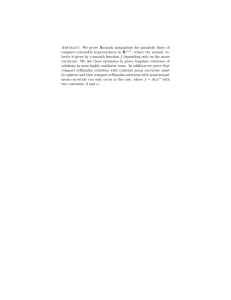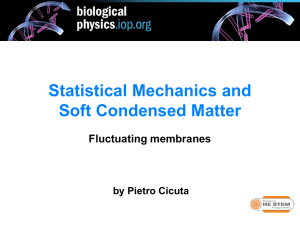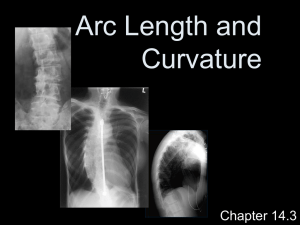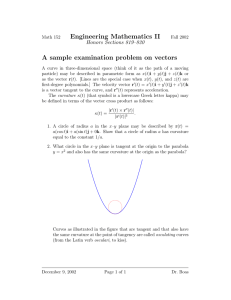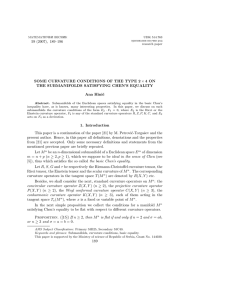59 (2007), 143–150 × THE SUBMANIFOLDS SATISFYING CHEN’S EQUALITY Miroslava Petrovi´
advertisement
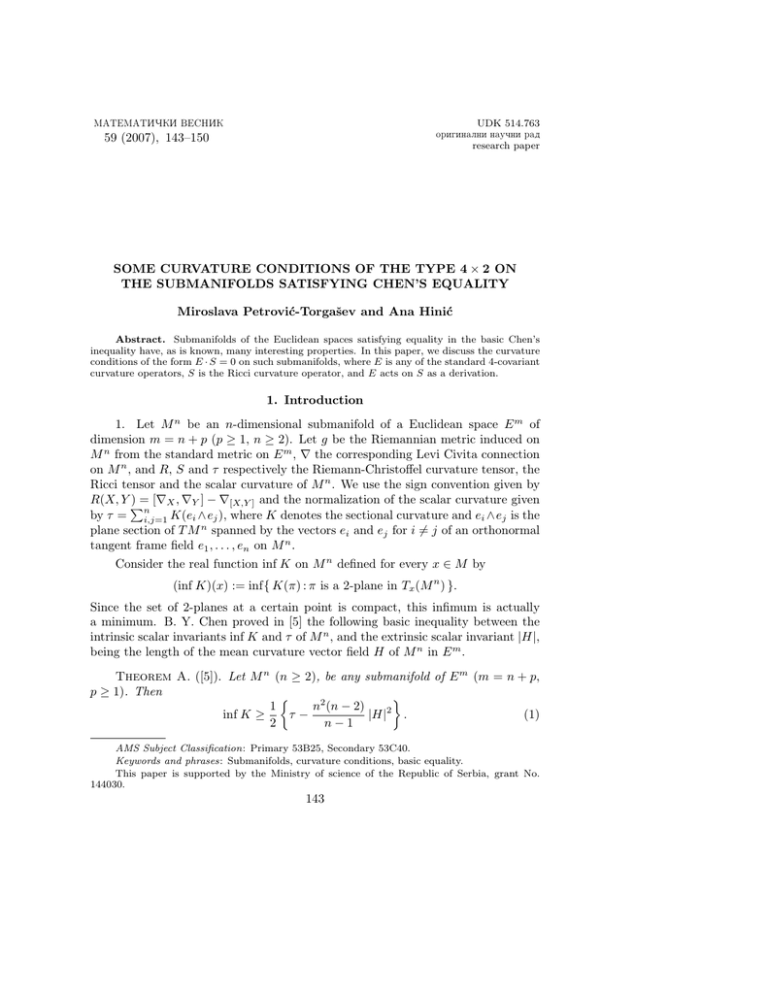
MATEMATIQKI VESNIK
UDK 514.763
originalni nauqni rad
research paper
59 (2007), 143–150
SOME CURVATURE CONDITIONS OF THE TYPE 4 × 2 ON
THE SUBMANIFOLDS SATISFYING CHEN’S EQUALITY
Miroslava Petrović-Torgašev and Ana Hinić
Abstract. Submanifolds of the Euclidean spaces satisfying equality in the basic Chen’s
inequality have, as is known, many interesting properties. In this paper, we discuss the curvature
conditions of the form E · S = 0 on such submanifolds, where E is any of the standard 4-covariant
curvature operators, S is the Ricci curvature operator, and E acts on S as a derivation.
1. Introduction
1. Let M n be an n-dimensional submanifold of a Euclidean space E m of
dimension m = n + p (p ≥ 1, n ≥ 2). Let g be the Riemannian metric induced on
M n from the standard metric on E m , ∇ the corresponding Levi Civita connection
on M n , and R, S and τ respectively the Riemann-Christoffel curvature tensor, the
Ricci tensor and the scalar curvature of M n . We use the sign convention given by
R(X, Y ) = [∇X , ∇Y ] − ∇[X,Y ] and the normalization of the scalar curvature given
Pn
by τ = i,j=1 K(ei ∧ ej ), where K denotes the sectional curvature and ei ∧ ej is the
plane section of T M n spanned by the vectors ei and ej for i 6= j of an orthonormal
tangent frame field e1 , . . . , en on M n .
Consider the real function inf K on M n defined for every x ∈ M by
(inf K)(x) := inf{ K(π) : π is a 2-plane in Tx (M n ) }.
Since the set of 2-planes at a certain point is compact, this infimum is actually
a minimum. B. Y. Chen proved in [5] the following basic inequality between the
intrinsic scalar invariants inf K and τ of M n , and the extrinsic scalar invariant |H|,
being the length of the mean curvature vector field H of M n in E m .
Theorem A. ([5]). Let M n (n ≥ 2), be any submanifold of E m (m = n + p,
p ≥ 1). Then
½
¾
1
n2 (n − 2)
2
inf K ≥
τ−
|H| .
(1)
2
n−1
AMS Subject Classification: Primary 53B25, Secondary 53C40.
Keywords and phrases: Submanifolds, curvature conditions, basic equality.
This paper is supported by the Ministry of science of the Republic of Serbia, grant No.
144030.
143
144
M. Petrović-Torgašev, A. Hinić
Equality holds in (1) at a point x if and only if with respect to suitable local orthonormal frames e1 , . . . , en ∈ Tx M n and en+1 , . . . , en+p ∈ Tx⊥ M n , the Weingarten
maps At with respect to the normal sections ξt = en+t (t = 1, . . . , p) are given by
a 0 0 ... 0
ct dt 0 . . . 0
0 b 0 ... 0
dt −ct 0 . . . 0
0 0 µ . . . 0 , At = 0
0
0 . . . 0 (t > 1),
A1 =
. . .
..
..
..
..
. . .
...
.
.
.
. . .
.
0
0
0 ... 0
0 0 0 ... µ
where µ = a + b. For any such frame, inf K(x) is attained by the plane e1 ∧ e2 .
The purpose of the present paper is to study submanifolds M n of E m for which
the basic inequality (1) at all points is actually an equality. Such submanifolds are
called ideal submanifolds.
If S is the Ricci operator of a manifold M n in a Euclidean space, the Ricci
curvatures Rici = Sii (i = 1, . . . , n) of M n are given by
Rici = Ric(ei ) =
n
P
j=1
Kij ,
where Kij = K(ei ∧ ej ) (i, j = 1, . . . , n) are the corresponding sectional curvatures.
If, in particular, M n is satisfying the basic equality in (1), then we have
K12 = ab − σK1j = a µ, K2j = b µ, Kij = µ2 ,
Pp
for i, j > 2, where σ = t=2 (c2t + d2t ). In this case the Ricci curvatures Rici of M n
(i = 1, . . . , n) are given by
Ric1 = (n − 2) a µ + K12 ,
Ric2 = (n − 2) b µ + K12 ,
Ric3 = · · · = Ricn = (n − 2) µ2 ,
and we also have S(ei , ej ) = 0 if i 6= j. The scalar curvature τ = 2ab − 2σ +
(n − 1)(n − 2) µ2 . In the sequel, we shall also denote Ric1 = α, Ric2 = β, Ric3 = γ.
2. Next, we recall several curvature operators which we shall use in the sequel.
The concircular curvature operator Z(X, Y ) is defined for n ≥ 2 by
Z(X, Y ) = R(X, Y ) −
τ
B(X, Y ),
n(n − 1)
where τ = τ (x) is the scalar curvature of M n , and the operator B(X, Y )U =
(X ∧ Y )U = g(U, Y )X − g(U, X)Y (X, Y, U ∈ Tx (M n )). Note that, in components,
Bijkl = gil gjk − gik gjl .
The projective curvature operator P (X, Y ) is defined for n ≥ 2 by
P (X, Y )U = R(X, Y )U −
1
B(X, Y )(SU ).
n−1
Some curvature conditions of the type 4 × 2
145
The Weyl’s conformal curvature operator C is defined for n ≥ 3 by
1
τ
C(X, Y ) = R(X, Y ) −
{SX ∧ Y + X ∧ SY } +
B(X, Y ).
n−2
(n − 1)(n − 2)
As is well known, every submanifold of dimension n = 3 is conformally flat,
that is C = 0 identically holds on M 3 .
The conharmonic curvature operator K(X, Y ) is defined for n ≥ 3 by
1
K(X, Y ) = R(X, Y ) −
{SX ∧ Y + X ∧ SY }.
n−2
The Einstein curvature operator is defined for n ≥ 2 by G = S − nτ I, where I
is the identity operator on Tx (M n ).
As is well-known, every manifold M 2 is of constant sectional curvature (that is,
its curvature tensors Z and P vanish), and a manifold M n (n ≥ 3) is conharmonically flat if and only if it is conformally flat, and its scalar curvature τ identically
vanishes.
3. Now, assume that M n is a submanifold of the Euclidean space E m (m =
n + p, p ≥ 1, n ≥ 2) satisfying Chen’s basic equality. If we denote Rijk = R(ei , ej )ek
(i, j, k = 1, . . . , n), then a straightforward calculation of the curvature operator
R(X, Y )U gives that, in the orthonormal basis {e1 , . . . , en } of the tangent space
Tx (M n ), we have
R121 = R1 e2 , R122 = −R1 e1 ,
R
(p ≥ 3), R1pp = −R2 e1 (p ≥ 3),
1p1 = R2 ep
(2)
R2p2 = R3 ep (p ≥ 3), R2pp = −R3 e2 (p ≥ 3),
Rpqp = R0 eq (p, q ≥ 3, p 6= q),
Pp
where R1 = −K12 = σ − ab = t=2 (c2t + d2t ) − ab, R2 = −K1j = −a µ, R3 =
−K2j = −b µ and R0 = −Kij = −µ2 (i, j > 2). Besides, Rijk = 0 if all i, j, k are
mutually distinct.
Moreover, if E = E4 is any of the curvature operators R, Z, B, C, K, we get
the similar equations for the values Eijk = E(ei , ej )ek (i, j, k = 1, . . . , n), with the
corresponding functions Ei (i = 0, 1, 2, 3). We only give in short the exact values
for the functions Ei (i = 0, 1, 2, 3) in each of these cases.
(B): B1 = B2 = B3 = B0 = −1 at any point x ∈ M n .
τ
τ
Z1 = R1 + n(n−1) , Z2 = −a µ + n(n − 1) ,
(Z):
τ
τ
Z3 = −b µ +
, Z0 = −µ2 +
.
n(n − 1)
n(n − 1)
n−4
R1
(K): K1 =
R1 + µ2 , K2 = K3 = −
+ µ2 , K0 = µ2 .
n
−
2
n
−
2
n−3
n−3
C1 = n − 1 R1 , C2 = C3 = − (n − 1)(n − 2) R1 ,
(C):
2 R1
C0 =
.
(n − 1)(n − 2)
We note that each of the functions R0 , B0 , Z0 , K0 , C0 exists only if n ≥ 4.
146
M. Petrović-Torgašev, A. Hinić
We also note that the corresponding equations for the projective curvature
operator P differ of the previous because the corresponding curvature tensor is
not antisymmetric in the last two indices. In fact, denoting Pijk = P (ei , ej )ek
(i, j, k = 1, . . . , n), we find the following equations:
e
P121 = P1 e2 , P122 = P1 e1 , P1p1 = P2 ep (p ≥ 3),
(3)
P1pp = Pe2 e1 (p ≥ 3), P2p2 = P3 ep (p ≥ 3),
P2pp = Pe3 e2 (p ≥ 3), Ppqp = P0 eq (p, q ≥ 3, p 6= q),
where
Pe1 = − n−2
P1 = n−2
n−1 (R1 + a µ),
n−1 (R1 + b µ),
R
+a
µ
µ
1
P2 = −
Pe2 = n−1 [a − (n − 2)b],
n−1 ,
1 +b µ
P3 = − Rn−1
,
µ2
P0 = − n−1 .
Pe3 =
µ
n−1
[b − (n − 2)a],
Besides, Pijk = 0 if all i, j, k are mutually distinct, and P0 exists only if n ≥ 4.
Finally, denoting any of the tensors S, G by E, we find that the Ricci operator
S and the Einstein tensor G act as follows:
Ee1 = α e1 ,
Ee2 = β e2 ,
Eep = γ ep
(p ≥ 3),
where, if E = S: α = (n − 2) a µ − R1 , β = (n − 2) b µ − R1 , γ = (n − 2) µ2 , and, if
E = G: α0 = (n−2) a µ−R1 −τ /n, β0 = (n−2) b µ−R1 −τ /n, γ0 = (n−2) µ2 −τ /n.
In [15] it was proved that a submanifold M n (n ≥ 3) satisfying Chen’s equality
is flat if and only if it is totally geodesic. The last condition means that a = b =
σ = 0, thus that a = b = ct = dt = 0 (t = 2, . . . , p). There, it was also proven that
M n is Einstein if and only if n = 2, or it is flat.
In the next simple proposition we collect the conditions for a manifold M n
satisfying Chen’s equality to be flat with respect to different curvature operators.
Proposition 1. If n ≥ 2, then M n is flat if and only if n = 2 and σ = ab, or
n ≥ 3 and σ = a = b = 0.
If n ≥ 2, then M n is of constant curvature if and only if n = 2, or it is flat.
If n ≥ 3, then M n is conformally flat if and only if n = 3, or n ≥ 4 and
σ = ab.
If n ≥ 3, then M n if conharmonically flat if and only if it is flat, or n = 3 and
σ = ab + µ2 .
2. Main results
Throughout this section we suppose that M n is a submanifold in the Euclidean
space E m (m = n + p, p ≥ 1, n ≥ 2) satisfying the basic Chen’s equality, and we
investigate on such a submanifold several curvature conditions of the form E·F2 = 0,
Some curvature conditions of the type 4 × 2
147
where E is any of the curvature operators R, Z, P, K, C, F2 is any of the operators
S, G, and the operation E · F2 is defined as
(E(X, Y ) · F2 )U = E(X, Y )(F2 U ) − F2 (E(X, Y )U ),
for all tangent vectors X, Y, U ∈ Tx (M n ).
Similar curvature conditions of the form E4 ·F2 = 0, and of the form E4 ·F4 = 0
have been investigated in many papers (see e.g. [1–3],[7–10], [14–15], [18–20], [22–
33], etc.).
Since obviously E · G = E · S, we shall consider only the case F2 = S, thus we
shall discuss exactly the operations R · S, Z · S, P · S, C · S and K · S.
In the most simple case n = 2, we get that S = τ2 I (moreover, Z = P = 0),
so that R · S = Z · S = P · S = 0. Hence, this case is trivial and we can suppose
that n ≥ 3.
If n ≥ 3 and E is any of the curvature operators R, Z, K, C, then obviously
E·S = 0 if and only if (E·S)ijk = (E(ei , ej )·S)ek = 0 for all indices i, j, k = 1, . . . , n.
It is also not difficult to see that the above condition is satisfied if and only if the
following three equations hold:
(E · S)121 = (E · S)131 = (E · S)232 = 0.
Hence, E · S = 0 if and only if the next system of equations is satisfied:
(α − β) E1 = 0,
(α − γ) E2 = 0,
(β − γ) E3 = 0.
(4)
By an easy discussion of the corresponding system in any of the cases E =
R, Z, K, C we get the following theorems.
Theorem 1. If n ≥ 3, then R · S = 0 if and only if one of the following three
cases occurs: (10 ) µ = 0; (20 ) σ = a = 0, b 6= 0; (30 ) σ = b = 0, a 6= 0.
Proof. By direct calculations, it is easy to check that R · S = 0 in any of the
cases (10 ), (20 ), (30 ).
Next, assume that R · S = 0 and µ 6= 0. Supposing that a, b 6= 0, by equations
(R · S)131 = 0 and (R · S)232 = 0, we get
R1 = −(n − 2) a µ = −(n − 2) b µ,
and consequently a = b, σ = −(2n − 5) a2 . Therefore σ = a = 0, a contradiction.
Hence, ab = 0. If a = 0, then the third equation gives b σ = µ σ = 0, thus σ = 0
(because µ 6= 0), so we have the case (20 ). If b = 0, we similarly have the case
(30 ).
Lemma 1. If n ≥ 3 and Z1 = 0, then M n is a totally geodesic plane.
Proof. Note that equation Z1 = 0 in the developed form reads:
(n + 1)σ = −(n − 1) a2 − (n − 1)b2 − (n − 3) ab.
Since n ≥ 3, the previous equality is possible only if σ = a = b = 0, which means
that M n is totally geodesic n-plane in E m .
148
M. Petrović-Torgašev, A. Hinić
Theorem 2. If n ≥ 3, then Z · S = 0 if and only if one of the following
cases occurs: (10 ) M n is a totally geodesic plane; (20 ) n ≥ 4, a = b and σ =
(n2 − 5n + 5) a2 .
Proof. If n ≥ 4, σ = (n2 − 5n + 5) a2 , a = b, then Z2 = Z3 = 0, α = β, and
immediately Z · S = 0.
Conversely, assume that n ≥ 3, Z · S = 0, and M n is not totally geodesic
plane. Then by Lemma 1, Z1 6= 0. By equation (Z · S)121 = 0, we get a = ±b.
Supposing that µ = 0, we have τ = −2 R1 = −2(σ + a2 ), Z1 = (n+1)(n−2)
R1 , and
n(n−1)
2
n
by (Z · S)131 = 0 we get a contradiction R1 = σ + a = 0, M is a totally geodesic
plane. If a = b, then
Z2 = −
2
{σ − (n2 − 5n + 5) a2 },
n(n − 1)
R1 + (n − 2) b µ = σ + (2n − 5) a2 > 0,
and by equation (Z · S)131 = 0, we obtain Z2 = 0, i.e. σ = (n2 − 5n + 5) a2 . Since
M n is not totally geodesic, the case n = 3 is excluded, so that n ≥ 4, and we have
the case (20 ).
Lemma 2. If n ≥ 3 and K1 = K2 = 0, then M n is conharmonically flat.
Proof. If K1 = K2 = 0, then easily R1 = (n − 2) µ2 and (n − 3) µ2 = 0. If
µ = 0, then R1 = 0, and we obtain that M n is totally geodesic plane. If n = 3,
then R1 = µ2 , and we again get that M n is conharmonically flat.
Theorem 3. If n ≥ 3, then K · S = 0 if and only if one of the following cases
occurs: (10 ) M n is conharmonically flat; (20 ) a = b 6= 0, σ = (4n − 7) a2 .
Proof. If a = b and σ = (4n − 7) a2 , then K2 = 0 and α = β, so that the
condition K · S = 0 is obviously satisfied.
Conversely, assume that n ≥ 3 and K · S = 0. If K2 6= 0, then by equations
(K · S)131 = 0 and (K · S)232 = 0 we obtain
R1 = −(n − 2) a µ = −(n − 2) b µ,
and hence a = ±b. If a = b, then by R1 = −2(n − 2) a2 , we easily get that M n is
totally geodesic, contradicting to K2 6= 0. If a = −b, µ = 0, then σ = −a2 , and
M n is totally geodesic, again a contradiction. Hence K2 = 0, i.e. R1 = (n − 2) µ2 .
If, in addition, we assume that M n is not conharmonically flat, then by Lemma 2,
K1 6= 0. By equation (K · S)121 = 0, we then have a = ±b. If a = b, then
K2 =
(4n − 7) a2 − σ
= 0,
n−2
and hence σ = (4n − 7) a2 , so we have the case (20 ). If a = −b, µ = 0, then by
K2 = 0, we get R1 = 0, σ = −a2 , σ = a = b = 0, contradicting to K1 6= 0.
Some curvature conditions of the type 4 × 2
149
Theorem 4. If n ≥ 3, then C · S = 0 if and only if M n is conformally flat.
Proof. Suppose that C · S = 0 and M n is not conformally flat. Then n ≥ 4
and R1 6= 0. By equations (C · S)121 = 0, (C · S)131 = 0, we then get α = β = γ,
i.e. a = ±b and R1 = −(n − 2) b µ. If µ = 0, then we get a contradiction R1 = 0.
If a = b, then we get σ = −(2n − 5) a2 , and hence σ = a = 0, thus again a
contradiction R1 = 0.
Next, assume that n ≥ 3 and consider the condition P · S = 0. It is also
not difficult to see that (P · S)ijk = 0 for any choice of indices i, j, k = 1, . . . , n if
and only if the next equations are satisfied: (P · S)121 = (P · S)122 = (P · S)131 =
(P · S)133 = (P · S)232 = (P · S)233 = 0. Hence, the complete system of equations
for the operation P · S reads:
(
(α − β) P1 = (α − β) Pe1 = (α − γ) P2 = 0,
(5)
(α − γ) Pe2 = (β − γ) P3 = (β − γ) = Pe3 = 0.
Therefore, it is not difficult to get the following result.
Theorem 5. If n ≥ 3, then P · S = 0 if and only if M n is a totally geodesic
plane.
Proof. Assume that n ≥ 3 and P · S = 0. Then, by equations (P · S)121 =
0, (P · S)122 = 0, we find that a = ±b. If µ = 0, then by equation (P · S)131 = 0
we have R1 = 0, and M n is a totally geodesic plane. If a = b, then by the same
equation we have (σ + a2 ){σ + (2n − 5) a2 } = 0, thus σ = a = b = 0, so M n is again
totally geodesic.
REFERENCES
[1] R. L. Bishop, S. I. Goldberg, On conformally flat spaces with commuting curvature and Ricci
transformations, Canad. J. Math. 24 (5) (1972), 799–804.
[2] D. E. Blair, P. Verheyen, L. Verstraelen, Hypersurfaces satisfaisant á R · C = 0 ou C · R = 0,
Comptes Rendus Acad. Bulg. Sci. 37 (11) (1984), 1459–1462.
[3] N. Bokan, M. Djorić, M. Petrović-Torgašev, L. Verstraelen, On the conharmonic curvature
tensor of hypersurfaces in Euclidean spaces, Glasnik Matem. 24 (44) (1989), 89–101.
[4] B. Y. Chen, Geometry of Submanifolds, Marcel Dekker, New York, 1973.
[5] B. Y. Chen, Some pinching and classification theorems for minimal submanifolds, Archiv för
Mathematik 60 (1993), 568–578.
[6] M. Dajczer, L. A. Florit, On Chen’s basic equality, Illinois Journ. Math. 42 (1998), 97–106.
[7] J. Deprez, F. Dillen, P. Verheyen, L. Verstraelen, Conditions on the projective curvature
tensor of hypersurfaces in Euclidean spaces, Ann. Fac. Sci. Toulouse, V. Sér. Math. 7 (1985),
229–249.
[8] J. Deprez, M. Petrović-Torgašev, L. Verstraelen, Conditions on the concircular curvature
tensor of hypersurfaces in Euclidean spaces, Bull. Inst. Math., Acad. Sin. 14 (1986), 197–
208.
[9] J. Deprez, M. Petrović–Torgašev, L. Verstraelen, New intrinsic characterizations of conformally flat hypersurfaces and of Einstein hypersurfaces, Rend. Semin. Fac. Sci., Univ. Cagliari
55 (No. 2) (1987), 67–78.
[10] J. Deprez, P. Verheyen, L. Verstraelen, Characterizations of conformally flat hypersurfaces,
Czech. Math. J. 35 (110) (1985), 140–145.
150
M. Petrović-Torgašev, A. Hinić
[11] P. J. De Smet, F. Dillen, L. Verstraelen, L. Vrancken, A pointwise inequality in submanifold
theory, Arch. Math. 35 (1999), 115–128.
[12] R. Deszcz, On pseudosymmetric spaces, Bull. Soc. Math. Belg. 44 (fasc.1), ser. A (1992),
1–34.
[13] F. Dillen, S. Haesen, M. Petrović-Torgašev, L. Verstraelen, An inequality between intrinsic
and extrinsic scalar curvature invariants for codimension 2 embeddings, Journal Geom. and
Physics 52 (2004), 101–112.
[14] F. Dillen, M. Petrović-Torgašev, L. Verstraelen, The conharmonic curvature tensor and 4dimensional catenoids, Studia Univ. Babes–Bolyai Math. 33 (2) (1988), 16–23.
[15] F. Dillen, M. Petrović-Torgašev, L. Verstraelen, Einstein, conformally flat and semi-symmetric submanifolds satisfying Chen’s equality, Israel J. Math. 100 (1997), 163–169.
[16] F. J. E. Dillen, L. C. A. Verstraelen (editors), Handbook of Differential Geometry, Vol. I,
Elsevier, Amsterdam, 2000.
[17] B. Gmira, L. Verstraelen, A curvature inequality for Riemannian submanifolds in a semiRiemannian space forms, Geometry and Topology of submanifolds IX, World Sci., Singapore,
1999, pp. 148–159.
[18] Y. Matsuyama, Hypersurfaces with R · S = 0 in a Euclidean space, Bull. Fac. Sci. Engrg.
Cho Univ. 24 (1981), 13–19.
[19] Y. Matsuyama, Complete hypersurfaces with R · S = 0 in E n+1 , Proc. Amer. Math. Soc. 88
(1983), 119–123.
[20] K. Nomizu, On hypersurfaces satusfying a certain condition on the curvature tensor, Tôhoku
Math. J. 20 (1968), 46–59.
[21] M. Petrović-Torgašev, L. Verstraelen, Hypersurfaces with commuting curvature derivations,
Atti Acad. Pelor. dei Pericolanti, Cl. I, Sci. Fis. Mat. 66 (1988), 261–271.
[22] K. Sekigawa, On 4-dimensional Einstein spaces satsifying R(X, Y ) · R = 0, Sci. Rep. Nügata
Univ. 7 (ser. A) (1969), 29–31.
[23] K. Sekigawa, On some hypersurfaces satisfying R(X, Y ) · R = 0, Tensor, New Ser. 25 (1972),
133–136.
[24] K. Sekigawa, On some hypersurfaces satisfying R(X, Y )·R1 = 0, Hokkaido Math. J. 1 (1972),
102–109.
[25] K. Sekigawa, On some 3-dimensional complete Riemannian manifolds satisfying R(X, Y ) ·
R = 0, Tôhoku Math. J. 27 (ser. A) (1975), 561–568.
[26] K. Sekigawa, H. Takagi, On conformally flat spaces satisfying a certain condition on the
Ricci tensor, Tôhoku Math. J. 23 (1971), 1–11.
[27] Z. I. Szabó, Structure theorems on Riemannian spaces satisfying R(X, Y ) · R = 0, I. The
local version, J. Diff. Geometry 17 (1982), 531–582.
[28] Z. I. Szabó, Classification and construction of complete hypersurfaces satisfying R(X, Y )·R =
0, Acta Sci. Math. 47 (1984), 321–348.
[29] Z. I. Szabó, Structure theorems on Riemannian spaces satisfying R(X, Y ) · R = 0, II, Global
version, Geom. dedicata 19 (1985), 65–108.
[30] H. Takagi, An example of Riemannian manifold satisfying R(X, Y ) · R = 0 but not ∇R = 0,
Tôhoku Math. J. 24 (1972), 105–108.
[31] S. Tanno, Hypersurfaces satisfying a certain condition on the Ricci tensor, Tôhoku Math. J.
21 (1969), 297–303.
[32] S. Tanno, A class of Riemannian manifolds satisfying R(X, Y ) · R = 0, Nagoya Math. J. 42
(1971), 67–77.
[33] L. Verstraelen, Comments on pseudo-symmetry in the sense of Ryszard Deszcz, in: Geometry
and Topology of Submanifolds, VI, World Sci., Singapore, 1994, pp. 199–209.
(received 17.04.2007, in revised form 25.07.2007)
Dep. of Math., Faculty of Sci., Radoja Domanovića 12, 34000 Kragujevac, Serbia.
E-mails: mirapt@kg.ac.yu, anahinic@kg.ac.yu

